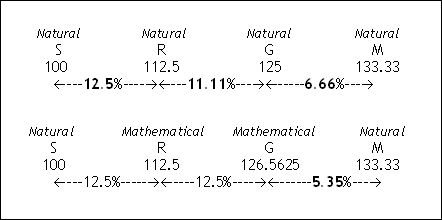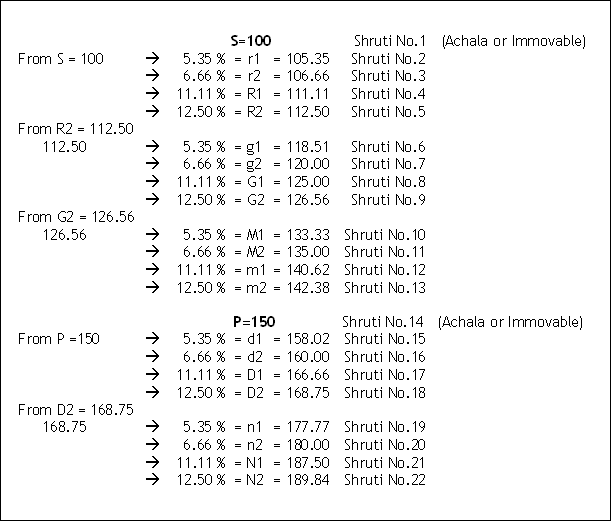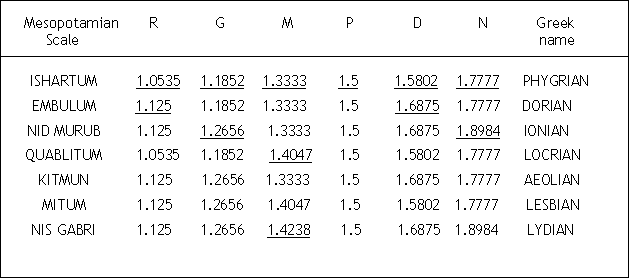I was struggling hard to decifer the mathematics behind 22 shrutis.
As days and months passed by in tedious calculations, I was becoming certain that there had to be a 'simpler' method to get to the Shrutis, and I was not succeeding probably because of only trying the difficult paths.
One day, I went back to basics.
The Saptak was 'S-R-G-M' repeated twice, forming the complete Saptak (P-D-N-S' are actually, S-R-G-M from P).
The secret must be here, I thought, and one day, I started studying the inter-relationships between these 4 notes.
Out of these notes, S and M were "Natural" and well-defined by Nature at 100 and 133.33 % respectively. The notes R and G were different "in Nature" and "as arrived Mathematically" (By Pythagoras), giving the following differences. (Refer to following table)

Table shows Basic Mathematical percentages creating 22 Shrutis: the differences in Natural S, R, G, M ; and Natural S, M, and Mathematical R and G
My findings were as follows:
- 1The distances between Natural S and Natural R was 12.5%.
- 2The distance between Natural R and Natural G was 11.11%.
- 3The distance between Natural G and Natural M was 6.66%.
- 4The distance between Mathematical G and Natural M was 5.35%.
The figure of 5.35 struck a note in my mind, as, earlier, I had also studied the Pythagorean Octave where he had found that 5.35 was the famous Pythagorean Limma!
The notes S, R, G, and M are identified and easily sung even by small children without any musical training.
There must be a natural "setting' in the brain to differentiate these distances, I thought. It occurred to me that surely, this must be the starting point.
And, when I rearranged the above distances, 5.35%, 6.66%,11.11%, and 12.5%, and starting from S taken (as 100 hz), the 22 Shrutis unearthed themselves accurately to my astonishment. (Refer to following table)

Table shows S-R-G-M based Derivation of 22 Shrutis (based on % difference values between S,R,G,M, which are 5.35, 6.66, 11.11, and 12.5 respectively)
S' of course is 200. Interestingly, the distance between m2-P; and N2-S' was also exactly 5.35% confirming that the 22 Shrutis were fitting snugly and mathematically in the space between 100 and 200.
THE JigSaw puzzle was solved!
There were no extra pieces, and no extra space.


Dear sir
I am a bit perplexed at the frequencies calculated for the 12 notes. One example is, Bhatkhande says GA is 301.4 Hz but you say it should be 300 Hz based on Western formulation. Indian system is based on length of Veena string I think. Please help me clarify. I have read your entire website but unless I'm convinced that Bhatkhande is wrong JUST because he followed the 'hearing' method, is not acceptable so easily.